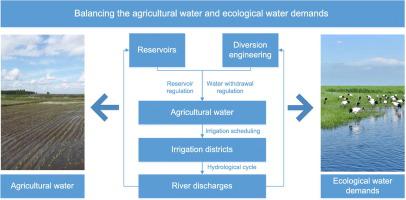Science of the Total Environment ( IF 9.8 ) Pub Date : 2020-11-21 , DOI: 10.1016/j.scitotenv.2020.143668 Weize Wang , Peng Hu , Jianhua Wang , Jianshi Zhao , Huan Liu , Zefan Yang

|
Agricultural water use is increasing quickly with the rapid socioeconomic development observed in the Wuyuer River basin. Water withdrawal for agriculture over the past decade have seriously depleted the ecological water requirements in the basin and damaged the channel and downstream wetland ecosystems. Achieving sustainable development in the basin will require a balance between agricultural water exploitation and ecological water demands. In this paper, a reservoir and diversion engineering module was integrated with a dualistic distributed hydrological model (WEP model) to investigate the effects of agricultural water use on river discharge. Agricultural water shortages and yearly minimum river discharges between 2020 and 2050 under six agricultural water exploitation scenarios and one natural scenario were estimated based on the proposed model. The results showed that the dualistic hydrological process model was more suitable for basins with agricultural water resource exploitation and that the river discharge was significantly less than the natural discharge due to irrigation and reservoir filling, especially in drought years. Under the scenarios of high, middle and low water resource exploitation without ecological operations, agricultural development was unsustainable because of agricultural water shortages and ecological water scarcity. The evaluation of the guaranteed rates for the agricultural water supply and environmental flows showed that the low water resource exploitation scenario with ecological operations was the best option and that sustainable development could be achieved in the basin under this exploitation scenario in the future. However, implementing water management practices in the basin could result in certain economic losses. These losses could be offset by ecological protection funds for downstream wetlands. Overall, the model results could help to inform planning and investment decisions within the basin to improve the sustainable management of water resources.
中文翻译:

基于蓄水调水工程模块的WEP模型的乌于尔河流域农业水可持续发展情景分析。
随着乌于尔河流域社会经济的快速发展,农业用水迅速增加。过去十年来,农业取水严重地耗尽了流域的生态需水量,破坏了河道和下游湿地生态系统。要在流域实现可持续发展,就需要在农业用水开发与生态用水之间取得平衡。本文将水库和引水工程模块与二元分布式水文模型(WEP模型)集成在一起,以研究农业用水对河流排放的影响。根据提出的模型,估计了2020年至2050年之间的农业用水短缺和每年最低河流排放量,其中有6种农业用水开发情景和1种自然情景。结果表明,二元水文过程模型更适合于农业水资源开发的流域,并且由于灌溉和水库充水,河流流量明显少于自然流量,特别是在干旱年份。在没有生态作业的情况下高,中,低水资源开发的情况下,由于农业缺水和生态缺水,农业发展是不可持续的。对农业供水和环境流量的保证率进行的评估表明,具有生态运作的低水资源开发方案是最佳选择,未来在这种开发方案下流域可以实现可持续发展。但是,在流域实施水管理做法可能会导致一定的经济损失。这些损失可以由下游湿地的生态保护资金来抵消。总体而言,模型结果可有助于为流域内的规划和投资决策提供依据,以改善水资源的可持续管理。在流域实施水管理实践可能会导致一定的经济损失。这些损失可以由下游湿地的生态保护资金来抵消。总体而言,模型结果可有助于为流域内的规划和投资决策提供依据,以改善水资源的可持续管理。在流域实施水管理做法可能会造成一定的经济损失。这些损失可以由下游湿地的生态保护资金来抵消。总体而言,模型结果可有助于为流域内的规划和投资决策提供依据,以改善水资源的可持续管理。


























 京公网安备 11010802027423号
京公网安备 11010802027423号